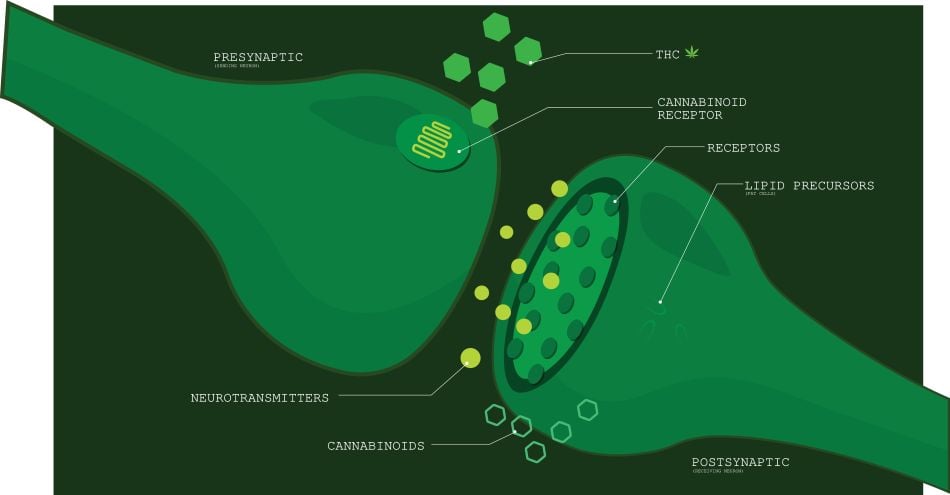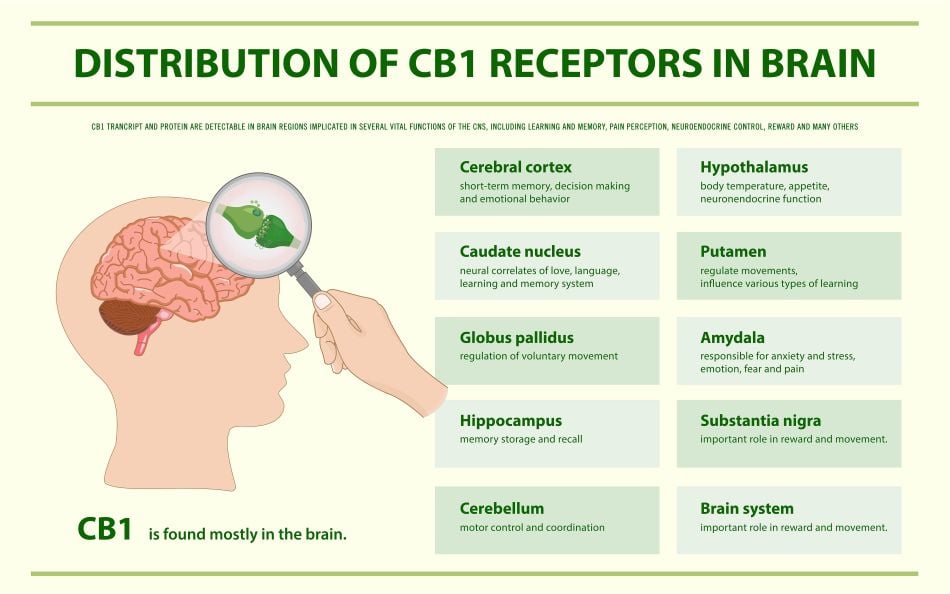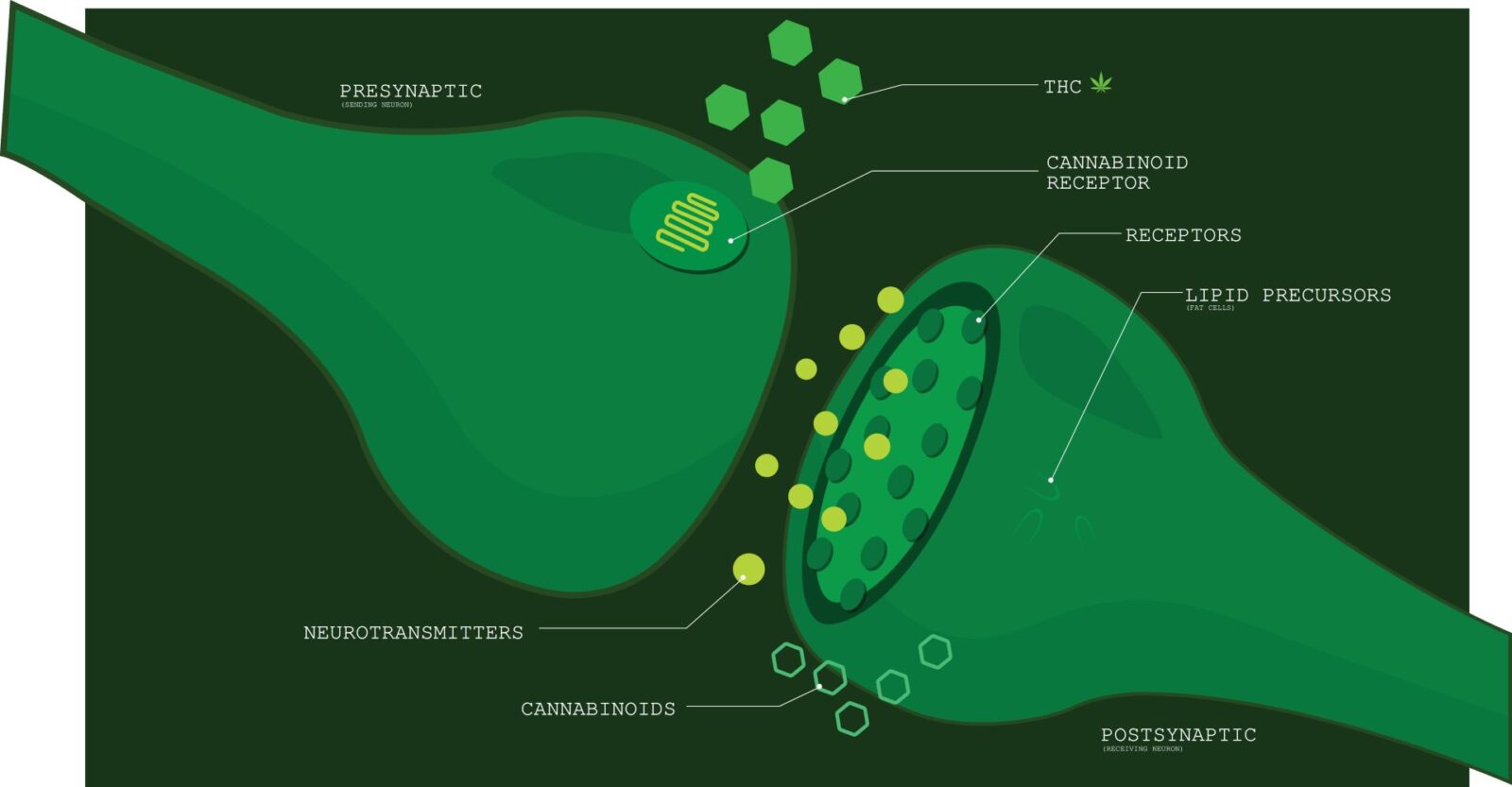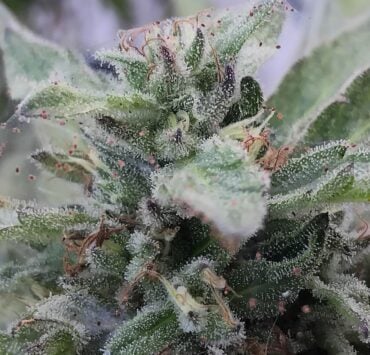Gold Header Ad
reserve your ad hereIf you’ve ever wondered why cannabis may lift your mood, spark your appetite, ease pain, or calm stress, the answer is your endocannabinoid system (ECS). The ECS is a built-in network that keeps the body balanced. It’s also one of the most overlooked systems when we talk about health, medicine, and cannabis. Think of the ECS as your body’s behind-the-scenes coordinator, making sure everything runs smoothly without you even noticing.
For the cannabis industry, understanding the ECS’s workings extends beyond mere science. It’s what helps with smarter product design, more reliable dosing, and giving consumers a clearer idea of what to expect.
Building Brains: The ECS and Development
The ECS is not just active in adults. It’s been working since before you were born. During pregnancy and early childhood, this system acts like a master architect for the brain—guiding neurons as they grow, move to where they’re needed, and connect into the networks that shape who you are.
It also manages neural progenitor cells, which are the raw materials for new brain cells. Then there’s synaptic pruning, where the ECS trims away unneeded connections so brain circuits are efficient—like trimming branches so a tree grows stronger.1
This is essential work. The ECS helps shape circuits for memory, emotion, social behavior, and thinking skills. It also keeps brain activity balanced, so it’s not running too hot or too cold. If the ECS is disrupted during these key stages—say, by prenatal THC exposure—brain wiring may be affected. While we need more research, this may cause long-term changes in how someone responds to stress, reward, and learning.

How THC and CBD Interact with the ECS
The ECS runs on two key messengers that your body makes naturally: anandamide (AEA), sometimes called the “bliss molecule,” and 2-arachidonoylglycerol (2-AG), which is especially important in pain control. These endocannabinoids work a lot like THC and CBD, but they’re made inside you, on demand.
THC is a full agonist at CB1 receptors and a partial agonist at CB2 receptors. CB1 receptor activation within the brain is what gives you the familiar psychoactive “high.” It changes how brain cells communicate, making music sound richer, food taste better, and thoughts feel more creative.
CB2 activation doesn’t cause intoxication. Instead, it helps reduce inflammation and supports immune function. CBD works differently from THC—it doesn’t directly activate CB1 or CB2 receptors. Instead, it can change how THC interacts with the CB1 receptor, sometimes reducing anxiety or paranoia. CBD also works on other systems like serotonin and TRPV1 and is not intoxicating.2
Research suggests that whole-plant cannabis, where cannabinoids, terpenes, flavorants, and other compounds found in cannabis work in tandem, may provide the greatest benefits. This is known as the entourage effect—something product formulators are increasingly leveraging in both medical and adult-use markets. One of the most common terpenes, beta-caryophyllene, is a CB2 receptor agonist, playing a role alongside THC in reducing inflammation.
Pain, Inflammation, and the ECS
The ECS plays a significant role in pain regulation, inflammation, and healing. CB1 receptors in the brain and spinal cord may help reduce the intensity of pain signals, while CB2 receptors on immune cells may help calm inflammation, especially in the brain.2
One of your body’s own endocannabinoids, 2-AG, is particularly good at shutting off pain transmission. Beta-caryophyllene, a common cannabis terpene also found in black pepper, activates CB2 receptors as well—showing how terpenes and cannabinoids can work together in reducing inflammation.3
This is especially relevant for conditions like Alzheimer’s disease, multiple sclerosis, and traumatic brain injury. ECS-based treatments are being studied for chronic pain, neuropathic pain, migraines, and fibromyalgia—and they may help reduce the need for opioid medications.4 For cannabis brands, that means a significant opportunity to design products that address pain through multiple pathways, not just THC content.
Stress, Anxiety, and the “Bliss Molecule”
When stress hits, the body’s HPA axis kicks in with fight-or-flight signals. The ECS acts as a natural brake, helping you return to baseline once the threat has passed.
Anandamide plays a key role here. It keeps the amygdala, your brain’s fear and stress center, in check. Chronic stress causes the body to break down anandamide faster using an enzyme called FAAH, which lowers your natural calm.
Animal studies suggest that blocking FAAH, and keeping anandamide levels higher, can reduce anxiety-like behavior. CBD may also help maintain anandamide levels indirectly, which is why it’s being studied for anxiety relief.4
Tolerance and CB1 Receptor Changes
When THC regularly activates CB1 receptors, the body adapts by reducing how sensitive and available those receptors are—a process called downregulation.
This means the same amount of THC has a weaker effect over time, creating tolerance. Fortunately, this is reversible. A tolerance break of a few weeks can allow CB1 levels to return to normal. Interestingly, tolerance may develop more to THC’s intoxicating effects than to some of its potential medical benefits.5
Brain scans show CB1 receptors are concentrated in regions that control memory, emotion, reward, and decision-making, such as the prefrontal cortex, hippocampus, amygdala, and striatum. In cannabis use disorder, CB1 levels drop in these areas, but dopamine receptor activity stays stable—unlike many other substances—suggesting cannabis impacts brain chemistry in unique ways.6

The Bottom Line for the Industry
Your ECS is quietly shaping brain function, regulating mood, controlling inflammation, and helping you recover from stress every single day. Cannabis doesn’t create these effects; it taps into a system that’s been part of human biology for millions of years.
For the cannabis industry, that means products work best when they’re designed with the ECS in mind. From fine-tuning cannabinoid blends for specific effects, to teaching consumers how tolerance works, to creating products that support the ECS beyond just THC and CBD—the future of cannabis innovation will come from working with the body’s natural system.
Quick Facts: The Endocannabinoid System (ECS)
What It Is:
Your body’s natural regulatory network for mood, pain, memory, appetite, and stress recovery.
When It Starts Working:
Active before birth—guides brain development, shapes neural connections, and keeps activity balanced.
THC’s Role:
- Fully activates CB1 receptors in the brain → produces the high.
- Partially activates CB2 receptors → helps manage inflammation.
CBD’s Role:
- Doesn’t directly activate CB1 or CB2.
- May reduce THC-related anxiety/paranoia.
- Works on other systems like serotonin and TRPV1.
Tolerance:
- Regular THC use can lower CB1 sensitivity (downregulation).
- Reversible with a few weeks’ tolerance break.
Pain & Inflammation:
- CB1 in brain/spinal cord → reduces pain signals.
- CB2 on immune cells → calms inflammation.
Stress & Anxiety:
- Anandamide (“bliss molecule”) keeps stress in check.
- Chronic stress breaks it down faster via FAAH.
- CBD may help sustain anandamide levels.
Big Takeaway:
Cannabis doesn’t create these effects on its own; it works with a system your body has relied on for millions of years.
References:
- Rodrigues RJ, Marques JM, Köfalvi A. Cannabis, Endocannabinoids and Brain Development: From Embryogenesis to Adolescence. Cells. 2024;13(22):1875. Published 2024 Nov 13. doi:10.3390/cells13221875
- Lu HC, Mackie K. An Introduction to the Endogenous Cannabinoid System. Biol Psychiatry. 2016;79(7):516-525. doi:10.1016/j.biopsych.2015.07.028
- Lowe H, Toyang N, Steele B, Bryant J, Ngwa W. The Endocannabinoid System: A Potential Target for the Treatment of Various Diseases. International Journal of Molecular Sciences. 2021; 22(17):9472. https://doi.org/10.3390/ijms22179472
- Ramaekers JG, Mason NL, Theunissen EL. Blunted highs: Pharmacodynamic and behavioral models of cannabis tolerance. Eur Neuropsychopharmacol. 2020;36:191-205. doi:10.1016/j.euroneuro.2020.01.006
- Ferland JN, Hurd YL. Deconstructing the neurobiology of cannabis use disorder. Nat Neurosci. 2020;23(5):600-610. doi:10.1038/s41593-020-0611-0
- 1Rodrigues RJ, Marques JM, Köfalvi A. Cannabis, Endocannabinoids and Brain Development: From Embryogenesis to Adolescence. Cells. 2024;13(22):1875. Published 2024 Nov 13. doi:10.3390/cells132218752Lu HC, Mackie K. An Introduction to the Endogenous Cannabinoid System. Biol Psychiatry. 2016;79(7):516-525. doi:10.1016/j.biopsych.2015.07.028
- 3Hashiesh HM, Sharma C, Goyal SN, et al. A focused review on CB2 receptor-selective pharmacological properties and therapeutic potential of β-caryophyllene, a dietary cannabinoid. Biomed Pharmacother. 2021;140:111639. doi:10.1016/j.biopha.2021.111639
- Lowe H, Toyang N, Steele B, Bryant J, Ngwa W. The Endocannabinoid System: A Potential Target for the Treatment of Various Diseases. International Journal of Molecular Sciences. 2021; 22(17):9472. https://doi.org/10.3390/ijms22179472
- Ramaekers JG, Mason NL, Theunissen EL. Blunted highs: Pharmacodynamic and behavioral models of cannabis tolerance. Eur Neuropsychopharmacol. 2020;36:191-205. doi:10.1016/j.euroneuro.2020.01.006
- Ferland JN, Hurd YL. Deconstructing the neurobiology of cannabis use disorder. Nat Neurosci. 2020;23(5):600-610. doi:10.1038/s41593-020-0611-0




